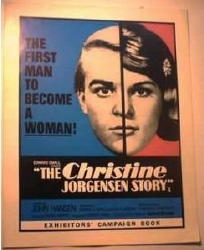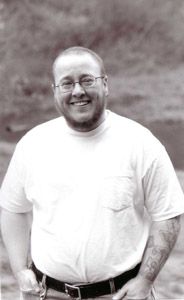Transgender
- Introduction
- History
- Epidemiology
- Diagnosis
- Treatment
- Trans Issues
- Internet Resources
Goal
At the completion of this module, the participant will better understand concepts of gender identity, transgender identity, and issues specific to transgender people. The participant will also increase knowledge of how a mental health provider can help a patient who is transgender.
Objectives
In order to reach this goal, the participant will:
- Learn about the history of the evolution of transgender expression and medical and psychiatric theories of gender identity
- Learn the current state of thinking on etiology of transgender identity
- Learn the criteria for the diagnosis of Gender Identity Disorder (GID) and about considerations for its revision
- Learn about current treatment interventions
Pre-Test
- Transsexualism is a phenomenon that arose in the 1950s
- true
- false
- Treatment for transgender people requires:
- Psychotherapy
- Hormones
- Sex reassignment
- All of these or possibly no medical treatment
- Male to female transgender people; are sexually attracted to:
- only men
- only women
- both men an women
- may be attracted to men, women, or both
Introduction
People who do not fit a conventional definition of male or female, masculine or feminine, have been a part of every culture in the world since our early history. These include people with an atypicial gender role (behaviors and appearance), to transgender people, whose gender identity (their sense of being male, female, or something in between) differs from their birth sex.
This module will discuss transgender history, the psychiatric diagnosis of Gender Dysphoria, and issues specific to the transgender population, including treatment needs.
We use the term gender variance to mean any degree of cross-gender identification or gender non-conformity in gender role behavior, regardless of whether the child or adult meets criteria for Gender Dysphoria (GD). The term transsexual, used less often today, means an adult who has changed sex through treatment with hormones and/or surgery. Transgender is a more inclusive term which can describe a person with cross-gender identification, in-between gender identification, or non-binary or other gender identification, and does not imply whether or not the person has used medical interventions such as hormones or surgery. Genderqueer is a relatively new term that is used by many people across the gender spectrum who do not feel the term transgender adequately describes them and often includes people who have a mixed or fluid gender identity.
A person who is born male and identifies as female is often called a male to female transgender person (MTF) or transgender woman. Similarly, someone born female who identifies as male is a female to male transgender person (FTM) or transgender man.
History
Our character, the manner in which we feel, our entire temperament is not masculine, it is feminine. We only act male. We play the male just as an actress plays a man on stage. . . . It is impossible for us to transform our female instinct into a male instinct.
-- Karl Heinrich Ulrichs
 Karl Heinrich Ulrichs (1864) was describing men who in
today’s lexicon would be called "gay." He coined the word "Urnings" for
them. He characterized Urnings as having "a female psyche caught in a
male body" and an erotic attraction exclusively to men. Subsequently,
he recognized that there were also "sexually inverted" women. Although
he wrote as a lawyer battling Prussian antisodomy laws, his evidence
for the naturalness of this condition was drawn from biomedicine. In
the second half of the nineteenth century, European forensic doctors
and neuropsychiatrists became increasingly interested in the "sexual
perversions": conditions that had previously been in the jurisdiction
of moralists and lawyers. Indeed, Victorian physicians first described
"sexual inversion" (1869), "exhibitionism" (1877), "homosexuality"
(1880), "amorous fetishism" (1887), "sadism and masochism" (1890), and
"heterosexuality" (referring to "inclination to both sexes") (1892).
Ulrichs's condition was subsumed under the diagnosis of inversion or
homosexuality, although the element of cross-dressing became an
independent focus of attention after sexologist Magnus
Hirschfeld coined the term "transvestite" in 1910.
Karl Heinrich Ulrichs (1864) was describing men who in
today’s lexicon would be called "gay." He coined the word "Urnings" for
them. He characterized Urnings as having "a female psyche caught in a
male body" and an erotic attraction exclusively to men. Subsequently,
he recognized that there were also "sexually inverted" women. Although
he wrote as a lawyer battling Prussian antisodomy laws, his evidence
for the naturalness of this condition was drawn from biomedicine. In
the second half of the nineteenth century, European forensic doctors
and neuropsychiatrists became increasingly interested in the "sexual
perversions": conditions that had previously been in the jurisdiction
of moralists and lawyers. Indeed, Victorian physicians first described
"sexual inversion" (1869), "exhibitionism" (1877), "homosexuality"
(1880), "amorous fetishism" (1887), "sadism and masochism" (1890), and
"heterosexuality" (referring to "inclination to both sexes") (1892).
Ulrichs's condition was subsumed under the diagnosis of inversion or
homosexuality, although the element of cross-dressing became an
independent focus of attention after sexologist Magnus
Hirschfeld coined the term "transvestite" in 1910.

Ulrichs’ characterization of gay men as being “females caught in a male body” provides and early example of the confusion and interplay between gender identity and sexual orientation, concepts that remain both intertwined and incorrectly conflated with each other today.
Even though Hirschfeld had coined the term "transsexual" in 1923, in the early 20th century, homosexuality, transvestitism, and cross-gendered self-identification were regularly collapsed together in the medical literature. For example, the first two patients who underwent complete "genital transformation surgery" from male to female in 1931 were diagnosed as "homosexual transvestites" and the surgery was performed to "complete" their cross-dressing. Even Christine Jorgensen (whose sex change surgery brought transsexualism to broad public attention in 1952) was originally diagnosed with "genuine transvestitism."
In the 1950's, John Money and his colleagues at the Johns Hopkins
University made the distinction between gender role (behavior that is
typically masculine or feminine) and gender identity
(self-identification as male or female) in arguing for early surgical
sex assignment of hermaphroditic children. Psychoanalyst Robert Stoller
developed the notion of "core gender identity" (1964).
 Endocrinologist Harry
Benjamin's seminal publications in the 1950s and 1960s were most
important in disseminating the diagnosis of transsexualism. It first
appeared in the Diagnostic and Statistical Manual (DSM)-III
along with psychosexual disorders. However, in DSM-III-R , Transsexualism was
included among the Gender Identity Disorders First Evident in Childhood
or Adolescence. The essential features of these is an "incongruence
between assigned sex... and gender identity," and resultant gender
dysphoria or discomfort about one's assigned sex and sexual body. DSM-IV-TR grouped Gender Identity
Disorder with Sexual Dysfunctions and Paraphilias (the fetishes).
Endocrinologist Harry
Benjamin's seminal publications in the 1950s and 1960s were most
important in disseminating the diagnosis of transsexualism. It first
appeared in the Diagnostic and Statistical Manual (DSM)-III
along with psychosexual disorders. However, in DSM-III-R , Transsexualism was
included among the Gender Identity Disorders First Evident in Childhood
or Adolescence. The essential features of these is an "incongruence
between assigned sex... and gender identity," and resultant gender
dysphoria or discomfort about one's assigned sex and sexual body. DSM-IV-TR grouped Gender Identity
Disorder with Sexual Dysfunctions and Paraphilias (the fetishes).
In the 1990s, there was an expansion of thinking in academia as part of a post-modern theory revolution, which significantly changed the landscape for transgender people. Scholars challenged the notion of the gender binary: the idea that one has to identify as male or female, and there is nothing in between. The simple notion that a transgender person is someone stuck in the body of the opposite gender was joined by a more complicated analysis of the gender binary itself, which opened the way for the expression of multiple genders within and without the traditional confines of masculine and feminine. Some transgender people began claiming identities between male and female, using labels such as “genderqueer” or refusing to self-label at all. This has led to a need to re-conceptualize transgender. Is it pathological or is it part of the abundant variance that is part of human biology? How much does biology vs. culture determine one’s gender?
The field of psychiatry grappled with the controversial DSM diagnosis of Gender Identity Disorder prior to the 2013 publication of DSM 5 and the new diagnosis Gender Dysphoria. Debate over the diagnosis centered around questions of how to usefully define pathology for the purpose of gaining and maintaining access to care, while removing stigma from transgender identity. Advocates in favor of a diagnosis cited the need to diagnose and treat those whose gender sufferings induce severe psychiatric symptoms and suicidal thinking. Advocates in favor of removal of the diagnosis from the DSM argued that the diagnosis itself contributes to stigma and discrimination in a way that creates disorder for transgender people around the world, in a similar way that the diagnosis of homosexuality, no longer included in DSM, contributed to pathologization of the gay community. There is an accepted view that the removal of homosexuality from the DSM was a historically instrumental moment in the shift for civil rights for the gay community and that current trends in favor of civil rights for this group would not have occurred without the dismantling of that diagnosis. Questions remain as to whether or not the same holds true for transgender people (Drescher 2009). In response to these concerns, the World Health Organization, which is currently revising the 11th edition of the International Classification of Diseases (ICD-11) for 2018 has recommended: (1) replacing the ICD-10 diagnosis of transsexualism with a diagnosis called "gender incongruence," and (2) removing the diagnosis from ICD's mental disorders section and moving it to a new section called "Conditions Related to Sexual Health."Despite the historical lumping of homosexuality and transgender
identity, the two are not the same. Someone with a transgender identity
can be attracted to men, women, or both. The potential need for medical
intervention (hormones and/or surgery) for gender transition keeps
transsexuality in the medical realm. Psychiatry plays an important role
for transgender people who need support exploring their psychological
makeup, understanding the choices before them, navigating the medical
system when transition technology is needed (including letters of
support), and helping a person manage positive and negative aspects of
a transition whether they chose medical, social, or a combination of
changes.
The American Psychiatric Association (APA) has issued position statements opposing discrimination against transgender people and advocating for access to treatment. The APA is studying the need for published recommendations to guide psychiatrists on the mental health needs of this population.
Epidemiology
The best epidemiological data on transsexualism come from the United Kingdom, the Netherlands, and Denmark where sex reassignment treatment is largely centralized. Dutch studies suggest a prevalence of adult transsexualism of 1 male-to-female (MTF) transsexual in 11,900 males and 1 female-to-male (FTM) in 30,400 females. The broader category of cross-gender behavior is more difficult to estimate; however, in children it has been reported as high as 10-16 percent.
Early estimates of sex ratio suggested a preponderance of MTFs over FTMs. However, with greater cultural and professional awareness of FTMs, a sex ratio of 4 MTF: 1 FTM or even parity has been suggested in certain countries. In short, we have even a dimmer picture of how many transgender people live in the US or elsewhere than we do for LGB people.
The lack of reliable data to help clinicians predict if and when children with transgender behavior will persist into adolescence and adulthood makes it difficult to know how a child should be treated and if social or medical transition is warranted. Studies show that 6-27% will continue with transgender feelings and behavior into adulthood.
Studies of risk factors in the US transgender population are limited, and there are no studies using representative samples. However, the preliminary data that exists is troubling. In a sample of 515 trans individuals in San Francisco, rates of depression were 62% in trans women and 55% in trans men. In a New York City sample of trans women, 52-54% had a lifetime history of depression, with rates highest in adolescence. Higher rates of suicide attempts and being the victim of violence have also been found in the transgender population. These burdens are likely to be a result of minority stress, stigma, discrimination, and bias against transgender people, resulting in actual violence and the stress of ongoing fear of violence.
Diagnosis
DSM 5 was unveiled in May 2013 with an updated diagnosis, Gender Dysphoria. The new diagnosis shifted the focus of disorder away from gender identity itself and onto the dysphoria that causes symptoms for many people who seek transition as well as those who do not.The diagnosis pertains to those who have a “marked incongruence between one’s experienced/expressed gender and assigned gender” of at least a six-month duration (A1 criterion). It must cause significant distress or impairment (criterion B.) There is a separate diagnosis for children and for adolescents and adults.
For children to have the diagnosis they must meet criterion A1 and have six out of eight A symptoms (including A1.) The other A symptoms include: a strong desire to be of the other gender or an insistence that he or she is the other gender (or alternative gender); a strong preference for cross-dressing or simulating attire of the opposite gender and a strong resistance to wearing the typical clothing of the assigned gender; strong preference for cross-gender roles in make-believe and fantasy play; strong preference for toys, games, or activities stereotypical for the other gender; a strong preference for playmates of the other gender; a strong rejection of toys, games and activities typical of the assigned gender; a strong dislike of one’s sexual anatomy; a strong desire for the primary or secondary sex characteristics that typically match one’s experienced gender.
For an adolescent or adult to meet criteria for the diagnosis they must also have the “marked incongruence” A1 symptom and two of six A criteria, all of which cause significant distress and impairment. The six A criteria include: marked incongruence between experienced/expressed gender and primary and/or secondary sex characteristics (in young adolescents, the anticipated secondary sex characteristics); a strong desire to be rid of one’s primary and/or secondary sex characteristics (in a young adolescent, a desire to prevent the development of the anticipated secondary sex characteristics); a strong desire for the primary and/or secondary sex characteristics of the other gender; a strong desire to be of the other gender (or some alternative gender); a strong desire to be treated as the other gender (or some alternative gender); a strong conviction that one has the typical feelings and reactions of the other gender (or some alternative gender.)
In addition to shifting the emphasis from identity disorder to dysphoria, the new DSM 5 diagnosis differs from the old GID diagnosis in several other important ways:
- The person’s gender identity need not align with the gender binary but can include “alternative gender.”
- The diagnosis is housed in its own chapter and no longer in the chapter on "Paraphilias and Sexual Dysfunction."
- There is no longer a sexual orientation specifier since sexual orientation is not relevant in determining the diagnosis.
- There is a new posttransition specifer that allows one to retain the diagnosis even after dysphoria may have been resolved through transition. This allows for continued use of the diagnosis to maintain access to medically necessary transition care that is essential across the lifespan.
- There is a new disorder of sex development (DSD) specifier. This recognizes the reality that GD and DSD are not mutually exclusive, as had been assumed in previous versions of DSM.
Treatment
The Harry Benjamin International Gender Dysphoria Association (HBIGDA, now known as the World Professional Association for Transgender Health, first published its Standards of Care (SOC) for transsexuals in 1979. The SOC 7, published in September 2011, represents an integrated effort between researchers, clinicians, and transgender people to establish a standard that accurately depicts modern scientific knowledge and is sensitive to the various and diverse issues faced by transgender people aroud the world. The SOC 7 do not prescribe a specific timeline for transition steps such as real life experience (living as the other gender), hormones, breast surgery (“top surgery”) and genital surgery (“bottom surgery”). Rather the SOC 7 provide flexible guidelines aimed at helping “transgender people find lasting comfort with their gendered selves, to maximize well-being, and to reduce harm.” There is also a recognition that every transgender person will not and need not choose to have every possible medical treatment. Some transgender people will choose to live as the other gender without taking hormones or having surgery. Some will use hormonal treatment but not surgery. These choices may stem out of concerns about medication and/or surgery effects, a desire to maintain reproductive function, personal medical history or risk factors, cost of treatments, or other individual reasons. The role of the treatment provider is to be knowledgeable about available treatments, to provide education and informed consent about risks and benefits, and to help the patient access care when needed.
Mental health professionals have traditionally been gatekeepers to hormone therapy, and many endocrinologists still require a letter from a therapist before they will initiate hormone treatment in a transgender person. The current SOC does not require psychotherapy to make a medical transition, but highly recommends it, not simply as a means to getting hormones and surgery, but as a source of support and guidance through the process of transition. Mental health clinicians can help patients through the person’s process of coming out as trans, as well as adjusting to their own bodies and others’ reactions to them as they transition.
A trans-affirmative therapist’s goals are to maximize the patient’s wellbeing, to expand exploration and understanding of their gender identity, and to support resiliency and coping during coming out and transitioning. Therapy should help the person look at their own expectations, whether realistic or not, in order to optimize their chance of satisfaction. It should allow for complex and not reductive exploration, including exploring the past and fantasy, and should include a history of the role of gender across the person’s life span. The cultural dynamics of race, ethnicity, age, gender, sexual identity, and socio-economic status and other aspects of human identity can be examined and integrated in a way that can help the transgender person move towards greater fulfillment.
Treatment for children is controversial and more complicated than that for adults, given that children’s bodies and brains are developing, and that we do not have great ability to predict which children will persist in their cross-gender identity. Gender dysphoria, distress due to discrepancy between gender identity and birth sex, can appear as early as age 2. It can also appear first or worsen at puberty, when the child’s body is changing in a way contrary to his or her felt identity. Studies have shown that 6-27% of children and adolescents with gender dysphoria will persist into adulthood.
The position of the WPATH, American Psychiatric Association (APA), and the American Academy of Child and Adolescent Psychiatry is that therapy with a gender atypical child should allow their gender identity to unfold without trying to influence the outcome one way or the other. The APA Task Force on the Treatment of GID identified the following aims of the mental health professional treating a gender variant child or child with GID: evaluation, diagnosis of GID, diagnosing co-morbid conditions and family disorders, introducing and discussing treatment options, psychotherapy for the child, educating family and institutions (such as school), and assessing safety of the child and family. An important need is for the therapist to assess the risk of bullying or other danger, and to integrate a safety plan into the treatment plan.
Puberty suppression, to buy a child time to come to a gender identity resolution, is becoming a standard of care for adolescents with GID. Cross-gender hormone treatment is much more controversial for adolescents. Two clinics that have done the most study on children and adolescents with GID are in Amsterdam and Toronto. While the Dutch clinic is more supportive of and assertive with full gender transition for adolescents, both clinics have access to puberty suppression treatment.
Trans Issues
Some issues for transgender people are parallel to those of LGB people. For example, transgender people go through a coming out process of self-awareness of transgender identity and disclosure to others. Like coming out for LGB people, this process is often lifelong. And like coming out for LGB people, transgender people can have awareness of gender dysphoria or gender difference from a very early age, or come to that awareness later in life.
Another commonality between LGB and transgender individuals is the experience of discrimination and bias. Transgender adults may be even more at risk for violence than LGB adults, and gender-atypical children and adolescents, whether gay or not, transgender or not, are at the highest risk of bullying.
The literature, whether clinical, research, or life stories by trans people themselves, is still more limited for transgender people as compared to LGB people. The 2011 Institute of Medicine Report, "The Health of LGBT People,” recommends more research into the needs of transgender people, including but not limited to access to medical treatments for transition
Awareness of the transgender community and transgender people has grown in recent years, partly due to the willingness of some public figures to be open about their transgender identity. A growing number of out trans people (for example, authors Patrick Califia and Leslie Feinberg, composer Wendy Carlos, biologist Joan Roughgarten, actress Laverne Cox, athlete Caitlyn Jenner, and advocates Jamison Green and Chaz Bono) have done much to increase acceptance of transgender people and to break down stereotypes.
Post-Test
- The estimated prevalence of male-to-female transsexualism is
- 1:1000 people born male
- 1:12,000 people born male
- 1:35,000 people born male
- 1:100,000 people born male
- The WPATH Standards of Care require what length of psychotherapy before approval for hormone treatment:
- 1 month
- 3 months
- 1 year
- no psychotherapy is obligatory
- The DSM 5 diagnosis of "Gender Dysphoria" is significantly different from the DSM IV "Gender Identity Disorder" diagnosis in which of the following:
- presence of distress and impairment
- desire for different secondary sex characteristics
- posttransition-resolved dysphoria applies
- importance of fantasy and make-believe play
Internet Resources
Benjamin, Harry. 1966. The Transsexual Phenomenon.
FTM International: primarily for female-to-male transgender people
International Foundation for Gender Education: has links and address for resources around the world
International Journal of Transsexualism
National Center for Transgender Equality
World Professional Association for Transgender Health. (2011). Standards of Care (SOC) for the Health of Transsexual, Transgender, and Gender Nonconforming People [Seventh Version].














